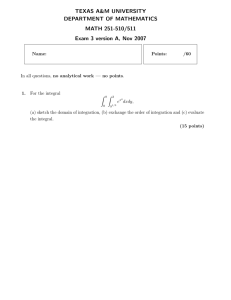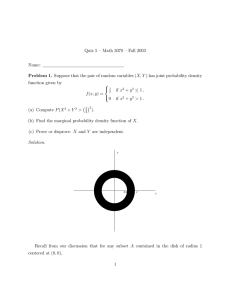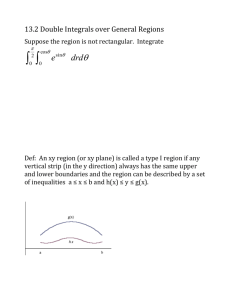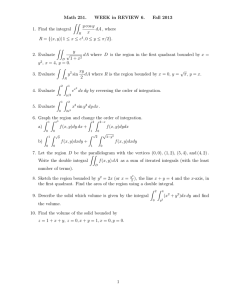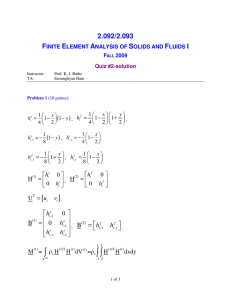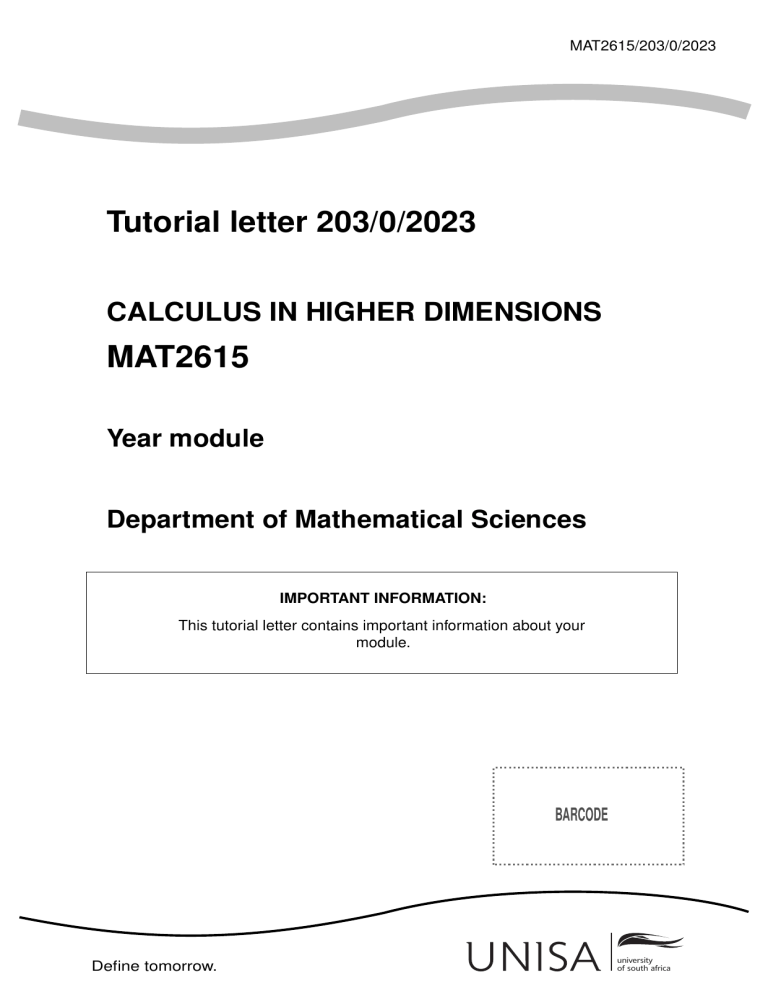
MAT2615/203/0/2023
Tutorial letter 203/0/2023
CALCULUS IN HIGHER DIMENSIONS
MAT2615
Year module
Department of Mathematical Sciences
IMPORTANT INFORMATION:
This tutorial letter contains important information about your
module.
BARCODE
Define tomorrow.
university
of south africa
Memorandum
1. Let the numbers be x, y, z.
Method 1: We use the method of Lagrange:
Minimise f (x, y, z) = x2 + y 2 + z 2
subject to the constraint g(x, y, z) = x + y + z − 27 = 0.
We compute:
gradf (x, y, z) = (2x, 2y, 2z)
gradg(x, y, z) = (1, 1, 1)
Then for some λ, (2x, 2y, 2z) = λ(1, 1, 1). Thus
2x = λ
2y = λ
2z = λ.
So x = λ/2, y = λ/2 and z = λ/2.
But x + y + z = 27, so
λ λ λ
+ +
= 27
2 2 2
λ = 18
and so
x = y = z = 9.
Method 2:
We find the critical points.
Minimise x2 + y 2 + z 2 given x + y + z = 27.
So z = 27 − x − y. Let
f (x, y) = x2 + y 2 + z 2
= x2 + y 2 + (27 − x − y)2 .
We want to find the critical points of f :
gradf (x, y) = 2x − 2(27 − x − y), 2y − 2(27 − x − y)
= (4x + 2y − 54, 2x + 4y − 54)
= (0, 0).
So we get the simultaneous equations
4x + 2y − 54 = 0
2x + 4y − 54 = 0.
2
(1)
(2)
MAT2615/203/0/2023
Subtracting (2)-(1) we get −2x + 2y = 0, so x = y.
Substituting this into (1), we see that
x=y = 9
z = 27 − x − y = 9.
Finally, we must verify that (9, 9) is a minimum for f :
fxx (9, 9) = 4 fxy (9, 9) = 2 fyy (9, 9) = 4
2
so ∆ = fxx fyy − fxy
= 12 > 0. Hence (9, 9) is an extremum. As fxx (9, 9) = 4 > 0, this is a
minimum.
2.
a) We rewrite Theorem 11.3.1 p133 of the Study Guide Book 2 for the case n = 3:
Consider an equation of the form f (x, y, z) = 0, where f is a smooth R3 − R function. If
(a, b, c) is an interior point of Df such that f (a, b, c) = 0 and ds ∂f
(a, b, c) ̸= 0, there exists
∂z
an open region A ⊂ R2 containing (a, b) and a unique smooth function g : A → R such
that
g(a, b) = c
f (x, y, g(x, y)) = 0 for every (x, y) ∈ A.
Furthermore,
∂f
(x, y, g(x, y))
∂g
∂x
(x, y) = − ∂f
∂x
(x, y, g(x, y))
∂z
∂f
(x, y, g(x, y))
∂g
∂y
(x, y) = − ∂f
∂y
(x, y, g(x, y))
∂z
for every (x, y) ∈ A.
b) We provide two answers for this question, using the points (1, e, 1) and (1, 1, 1).
The point (1,e,1).
Set f (x, y, z) = yx2 ez − zex . Then f is smooth and Df = R3 , so (1, e, 1) is an interior point
of Df .
∂f
(x, y, z) = yx2 ez − ex
∂z
∂f
(1, e, 1) = e2 − e ̸= 0
∂z
so all the conditions for the Implicit Function Theorem are met. Hence there is a unique
smooth function g such that
f (x, y, g(x, y)) = 0
about the point (1, e, 1). In particular g(1, e) = 1.
We calculate the derivatives of f to find the derivatives of g:
3
∂f
(1, e, 1) = 2e2 − e
∂x
∂f
(1, e, 1) = e.
∂y
∂f
(x, y, z) = 2xyez − zex
∂x
∂f
(x, y, z) = x2 ez
∂y
Therefore
∂g
e − 2e2
1 − 2e
(1, e) =
=
2
∂x
e −e
e−1
e
1
∂g
(1, e) = 2
=
.
∂y
e −e
e−1
A linear approximation of g (which is a Taylor first-order polynomial approximation) is of
the form
g(x, y) ≈ a + bx + cy
where
1 − 2e
e−1
1
=
.
e−1
b = gx =
c = gy
Thus g(x, y) ≈ a +
1
1 − 2e
x+
y.
e−1
e−1
At x = 1, y = e:
1 − 2e
e
+
e−1
e−1
1−e
1 = a+
e−1
1 = a−1
a = 2.
1 = g(1, e) = a +
Therefore
g(x, y) ≈ 2 +
1 − 2e
e
x+
y.
e−1
e−1
The point (1,1,1).
As above,
∂f
(x, y, z) = yx2 ez − ex ,
∂z
therefore
∂f
(1, 1, 1) = e − e = 0
∂z
so by the Implicit function theorem, there is no implicit function at the point (1, 1, 1).
3
4
MAT2615/203/0/2023
a) F (2, −1) = (0, 0) = F (−2, −1).
So the two points (2, −1) and (−2, −1) have the same image (that is, they are mapped to
the same point, (0, 0)).
Therefore F is not 1-1 and definitely not invertible.
b)
2x 0
.
y+1 x
Jf =
F is only invertible at (x, y) if the Jacobian JF (x, y) is invertible. This means that the
determinant must be nonzero.
det JF (x, y) = 2x2 ̸= 0.
Therefore x ̸= 0 and F is locally invertible on the set
{(x, y) ∈ R2 : x ̸= 0}
that is, the points not on the y-axis.
4.
a) Intersection of line and parabola:
4x + 1 = 5 − x2
x2 + 4x − 4 = 0
√
√
−4 ± 16 + 16
x =
= −2 ± 2 2.
2
Y
y = 4x + 1
5
√
8 2−7
R
√
−2 2 − 2
1
√
2 2−2
X
√
−8 2 − 7
y = 5 − x2
5
b) It is type I: vertical lines drawn in R are always bounded above by the parabola and
below by the line y = 4x + 1.
√
√
R = {(x, y) : − 2 2 − 2 ≤ x ≤ 2 2 − 2, 4x + 1 ≤ y ≤ 5 − x2 }.
√
c) It is not type II: horizontal lines drawn in R for which y ≥ 8 2 −√7 are bounded on the
left and right by the parabola and horizontal lines for which y ≤ 8 2 − 7 are bounded on
the left by the parabola and on the right by the line y = 4x − 1. So we describe R as the
union of two Type II regions R1 and R2 , as shown in the diagram below.
Y
R2
R1
X
Remember that in a Type II description, we have y bounded by expressions involving x
(which is the opposite of what happens in a Type I region). The following calculations will
help us with this.
y = 5 − x2
x2 = 5 − y
p
x = ± 5−y
and also
y = 4x + 1
1
x =
(y − 1).
4
In set-builder notation, the regions are described as follows.
p
p
√
R1 = {(x, y) : 8 2 − 7 ≤ y ≤ 5, − 5 − y ≤ x ≤ 5 − y}
p
√
√
1
R2 = {(x, y) : − 7 − 8 2 ≤ y ≤ 8 2 − 7, − 5 − y ≤ x ≤ (y − 1)}.
4
Finally, R = R1 ∪ r2 .
d)
6
i. The order of integration dy dx requires describing R as a Type I region (the x is
MAT2615/203/0/2023
bounded by numbers, not functions of y). We compute:
Z Z
Z
xy dydx =
√
2 2−2
Z
xy dydx
√
−2 2−2
√
Z 2 2−2
R
=
4x+1
1 2
xy
2
√
−2 2−2
Z 2√2−2
=
5−x2
5−x2
4x+1
dx
1
x (5 − x2 )2 − (4x + 1)2 dx
2
√
−2 2−2
√
2 2−2
Z
1 5
x − 13x3 − 4x2 + 12x dx
√
−2 2−2 2
√
1 6 13 4 4 3
2 2−2
=
x − x − x + 6x2 −2√2−2
12
4
3
= 422.3785.
=
ii. The order of integration dx dy requires describing R as a Type I region (the x is
bounded by numbers, not functions of y). We compute
Z Z
Z Z
Z Z
xy dxdy =
xy dxdy +
xy dxdy.
R
R1
Z Z
Z
xy dxdy =
R2
√
5
Z
xy dxdy
√
8 2−7
Z 5
R1
=
√
− 5−y
1 2 √5−y
x y −√5−y
2
√
8 2−7
Z 5
=
5−y
1
1
|5 − y| y − |5 − y| y dy
2
2
√
8 2−7
5
Z
=
Z Z
Z
xy dxdy =
R2
=
=
=
0 dy = 0.
√
8 2−7
√
8 2−7
√
−7−8 2
√
Z 8 2−7
√
−7−8 2
√
Z 8 2−7
√
−7−8 2
√
Z 8 2−7
√
−7−8 2
√
Z 8 2−7
Z
(y−1)/4
√
− 5−y
1 2
xy
2
xy dxdy
(y−1)/4
√
− 5−y
dy
1 1
y
(y − 1)2 − (5 − y) dy
2 16
1 1 2 1
1
y
y − y+
− 5 + y dy
2 16
8
16
1 3
7
79
y + y 2 − y dy
32
16
32
√
1 4
7
79 8 2−7
=
y + y 3 − y 2 −7−8√2 = 422.3785.
128
48
64
=
√
−7−8 2
7
Therefore
Z Z
Z Z
Z Z
xy dxdy =
R
5.
xy dxdy +
xy dxdy = 0 + 422.3785 + 422.3785.
R1
R2
√
a) −1 ≤ x ≤ 1; 0 ≤ y ≤ 1 − x2 .
√
If y = 1 − x2 , then x2 + y 2 = 1, so the XY -cross section is
Y
1
-1
1
X
p
p
Now 0 ≤ z ≤ 1 − x2 − y 2 , so if z = 1 − x2 − y 2 then x2 + y 2 + z 2 = 1, a sphere of
radius 1. The region of integration is:
Z
Y
X
b) The region of integration is a quarter sphere.
c) The quarter-sphere can be described, referring to the sketches in 2a), by
0≤θ≤π
0 ≤ ϕ ≤ π/4
0≤ρ≤1
for θ, look at the XY -projection.
ϕ is the angle from the vertical and any point
on the XY -plane (which is where ϕ has a
maximum for this problem) has ϕ = π/4
ρ is the distance from the origin; for a sphere
of radius 1, the maximum distance is 1, irrespective of the direction given by the angles
ϕ and θ.
Note that all three dimensions are bounded by numbers, not functions, which of course
makes the integration easy. Spheres are most easily described by spherical coordinates,
just as cylinders are most easily described by cylindrical coordinates, and rectangular
shapes by Cartesian coordinates.
As x = ρ sin ϕ cos θ and y = ρ sin ϕ sin θ,
x2 + y 2 = ρ2 sin2 ϕ
1 − x2 − y 2 = 1 − ρ2 sin2 θ.
8
MAT2615/203/0/2023
Therefore,
Z
1
√
Z
1−x2
Z √1−x2 −y2
2
Z
2
π
Z
π/4
Z
1
1 − x − y dzdydx =
−1
0
0
0
0
ρ2 sin2 ϕ 1 − ρ2 sin2 ϕ dρdϕdθ.
0
Note that the Jacobian of the spherical coordinates, ρ2 sin2 ϕ, has been added.
6. We use the formula
Z
C
x
ds =
1 + y2
Z
1
f (r(t))∥r′ (t)∥ dt.
0
We compute:
f (r(t)) = f (1 + 2t, t) =
1 + 2t
1 + t2
r′ (t) = (2, 1)
√
∥r′ (t)∥ =
5.
Therefore
Z
C
x
ds =
1 + y2
=
=
=
=
Z
1
f (r(t))∥r′ (t)∥ dt
√ Z 1 1 + 2t
5
dt
2
0 1+t
Z 1
√ Z 1 1
2t
5
dt +
dt
2
2
1+t
0 1+t
√ 0
1
1
5 arctan t 0 + ln(1 + t2 ) 0
√ π
5 + ln2 .
4
0
9
